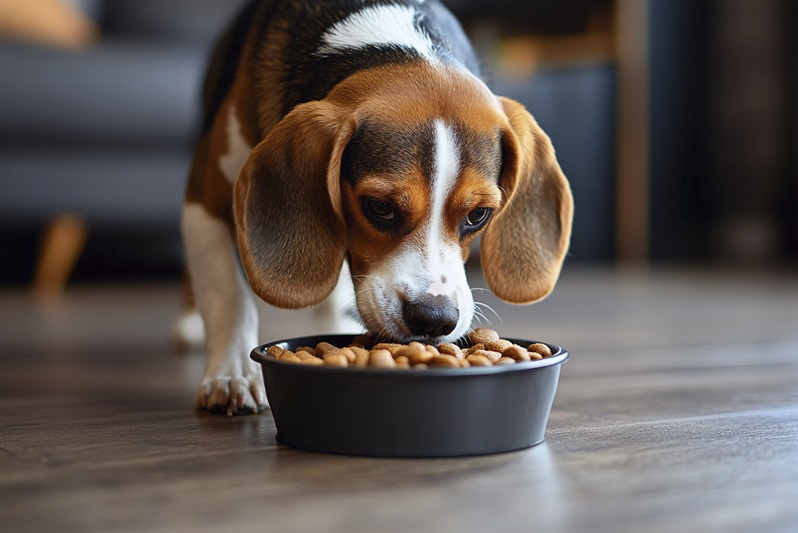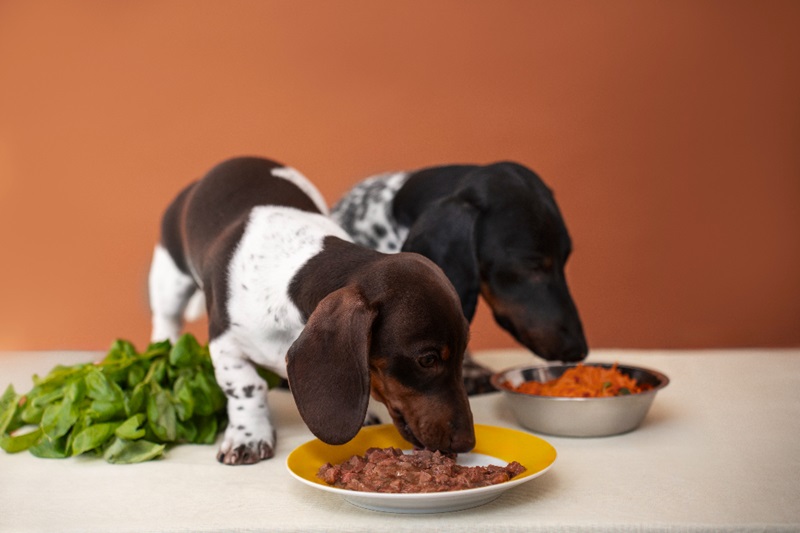What Active Dogs Need in Their Diet
Active breeds such as Border Collies, German Shepherds, and Siberian Huskies have unique dietary requirements to fuel their boundless energy and support their overall health. These dogs burn more calories, engage in strenuous activities, and need specific nutrients to maintain muscle health and stamina.
Here’s a detailed breakdown of what they need:
High Protein Content
Proteins play a vital role in repairing and building muscles, especially after rigorous activities. For active dogs, a diet rich in protein ensures that muscle recovery is efficient and energy levels remain high.
What to Look For: High-quality protein sources such as chicken, turkey, lamb, beef, or fish should be the primary ingredient in dog food.
Ideal Percentage: Aim for a protein content of 25-30% in their food. Working dogs or those involved in sports might benefit from protein levels closer to 35%.
Additional Benefits: Proteins also boost the production of enzymes and hormones essential for a dog’s overall health.

Healthy Fats for Energy
Fats are a concentrated energy source and are especially important for dogs engaging in high-intensity activities.
Key Nutrients: Omega-3 and Omega-6 fatty acids found in fish oil, chicken fat, and flaxseed are excellent for sustained energy and promoting healthy skin and a shiny coat.
Why They Matter: Fats also help in the absorption of fat-soluble vitamins like A, D, E, and K, which are critical for immunity and vision.
Tip: Look for foods with fat content ranging from 12-20% for optimal energy replenishment.
Complex Carbohydrates for Sustained Energy
Carbohydrates provide the slow-release energy needed for long play sessions or workdays.
Ideal Ingredients: Whole grains like brown rice, oats, and quinoa are excellent sources. Sweet potatoes, carrots, and pumpkin are also great as they are rich in fiber and nutrients.
What to Avoid: Stay away from fillers like corn, wheat, and soy, which offer little nutritional value and may lead to allergies or sensitivities.
Added Perks: Complex carbs also promote healthy digestion, thanks to their fiber content.
Essential Vitamins and Minerals
Active dogs require an array of vitamins and minerals to maintain strong immunity, healthy bones, and proper muscle function.
Vital Nutrients:
- Calcium and Phosphorus for bone strength and joint support.
- Vitamin D to aid calcium absorption.
- Antioxidants like Vitamin E and C to combat oxidative stress caused by strenuous activities.
- Zinc and Selenium for skin health and muscle repair.
Pro Tip: Ensure their diet includes chelated minerals (minerals bound to amino acids), as they are easier for dogs to absorb.
Hydration Matters
High-energy activities can lead to rapid dehydration, which impacts a dog’s performance and recovery.
Wet Food Advantage: Adding wet food to their diet helps increase their water intake.
Simple Hydration Tips: Always keep fresh water accessible, especially during or after exercise. For extra hydration, mix water or low-sodium broth into their kibble.
Types of Dog Food for Active Breeds
With an overwhelming number of dog food options available, choosing the right one can feel daunting. Here’s a detailed comparison to simplify your choice:
1. Dry Kibble
Benefits: Affordable, convenient, and has a longer shelf life.
Ideal Picks: High-protein options like Orijen, Blue Buffalo, and Merrick cater specifically to active dogs.
Key Tip: Check the label for “real meat” as the first ingredient and avoid products with artificial preservatives or fillers.
2. Wet Food
Benefits: More palatable and hydrating, making it ideal for picky eaters or dogs with lower water intake.
Best Brands: Hill’s Science Diet and Wellness CORE offer nutrient-dense options.
Usage: Incorporate as a treat or mix with kibble for a balanced meal.
3. Raw Diet
Why It Works: Mimics a natural ancestral diet with raw meat, bones, and vegetables.
Things to Note: Requires careful preparation to balance nutrients and minimize the risk of bacterial contamination.
Professional Guidance: Always consult a vet before transitioning to a raw diet.
4. Homemade Food
Control Factor: Allows you to customize ingredients to suit your dog’s specific needs.
Challenges: Time-consuming and requires expertise to ensure all nutritional needs are met.
Pro Tip: Work with a pet nutritionist to create a balanced recipe.
5. Freeze-Dried or Dehydrated Food
Advantages: Retains the nutrients of fresh food, lightweight, and ideal for travel.
Popular Choices: Brands like The Honest Kitchen and Stella & Chewy’s provide excellent options.
Storage: Easy to store and requires only water to rehydrate.

How to Choose the Best Dog Food
Selecting the right dog food goes beyond reading labels. Keep these factors in mind:
- Activity Level: Dogs engaging in high-energy activities need diets with higher caloric content compared to moderately active breeds.
- Breed Size: Large breeds may benefit from foods that support joint health (e.g., glucosamine and chondroitin), while smaller breeds require calorie-dense options.
- Life Stage: Puppies, adult dogs, and seniors have different nutritional needs—always choose age-specific formulas.
- Food Sensitivities: If your dog has allergies, avoid foods containing wheat, soy, dairy, or artificial additives.
Top Dog Food Brands for Active Breeds
- Orijen Original Dry Dog Food: Packed with free-run chicken and wild-caught fish. High-protein and grain-free formula.
- Taste of the Wild High Prairie: Uses real buffalo as its primary protein source. Includes sweet potatoes and peas for sustained energy.
- Blue Buffalo Wilderness Chicken Recipe: Rich in deboned chicken and antioxidants. Supports immune health and energy replenishment.
- Victor Hi-Pro Plus Formula: Formulated for active and sporting dogs. Provides high-quality proteins and fats.
- Wellness CORE Grain-Free High-Protein Formula: Features turkey, chicken, and salmon oil. Grain-free and packed with omega fatty acids.
Feeding Tips for Active Dogs
- Stick to a Routine: Feed your dog at consistent times to maintain stable energy levels.
- Monitor Portion Sizes: Adjust serving sizes based on activity level to avoid underfeeding or overfeeding.
- Offer Healthy Snacks: Use treats like freeze-dried liver or peanut butter to fuel energy bursts during activities.
- Gradual Food Transition: When switching foods, introduce the new diet gradually over 7-10 days to prevent digestive upsets.
FAQs on Best Dog Food for Active Breeds
- 1. How do I know if my dog’s food is meeting its energy needs?
- Check their weight, coat condition, and energy levels. If they’re losing weight or seem lethargic, their diet may need adjustments.
- 2. Can active dogs eat human food?
- Some human foods, like boiled chicken and rice, are safe. Avoid harmful foods like chocolate, onions, and grapes.
- 3. Should I give my active dog supplements?
- Only if recommended by your vet. Some dogs may benefit from joint or omega-3 supplements.
- 4. How often should I feed an active breed?
- Split their daily intake into two or three meals to maintain consistent energy.
- 5. What’s the best way to switch dog foods?
- Gradually mix the new food with the old one over 7-10 days to avoid upset stomachs.
Start Fueling Your Dog’s Energy
Choosing the right dog food is essential for keeping active breeds healthy and energetic. Look for high-quality ingredients, balanced nutrition, and foods tailored to their needs. Whether you choose dry kibble, wet food, or a raw diet, ensure it aligns with their lifestyle and health requirements. With the right diet, your dog will thrive, enjoying every adventure at full energy.

